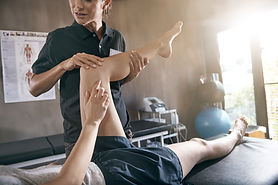Make this yours. Add images, text and links, or connect data from your collection.
ACL Injuries
The ACL or the Anterior Cruciate Ligament is one of the ligaments inside the knee along with the PCL which are arranged in a X fashion. The ACL is the one in the front.Traumatic injuries to the ACL occur to the athletes who participate in high risk sports such as wrestling, Kabaddi, Football, Rugby and Basketball etc. The majority of ACL injuries result from a sharp twisting of the knee, sudden deceleration while cutting, pivoting, and sidestepping movements, sudden stopping when running, and awkward landing from a jump. Other causes include direct contact, a fall or traumatic accident. Women who participate in college sports, such as: soccer, basketball, softball, lacrosse, rugby are four times more likely than men to rupture their ACL.
Yes, some ACL injuries can heal without surgery, especially incomplete injuries or what may be described as a sprain or partial tear. Even for complete tears of the ACL, conservative treatment (meaning no surgery) can potentially be successful in patients who do not intend to return to pivoting activities. However, patients with goals to return to high-risk sports will need surgical reconstruction
Knee arthroscopy is a minimally invasive procedure used to view, assess, and treat a torn ACL. ACL reconstruction involves the replacement of the ruptured ligament with a tendon graft. Knee arthroscopy can also be used to repair a torn meniscus also commonly found with an ACL rupture. ACL reconstruction involves replacing the torn ACL with tissue either taken from the patient (autograft) or taken from a tissue donor (allograft). The source of the graft tissue and the technique depends on the severity of the injury, age and activity level of the patient, desired outcome, and preferred method of the surgeon. Bone-patellar tendon-bone (BTB) autograft ACL reconstruction has the longest proven track record of successful outcomes, and is the technique to which all others are compared. Other options include the hamstring tendons (semitendinosus and gracilis) along the inner part of the thigh and knee. More recently, the quadriceps tendon has gained popularity as a graft source for ACL reconstruction.
Chondral Injuries
The goal of surgery is to improve symptoms, and restore function. In the past decade, there have been significant advancements in the surgical treatment of chondral defects. Cartilage restoration is one of Dr. Varshney’s areas of expertise which is surgery aimed at restoring the articular surface in young, active patients.
-
-
Arthroscopic Debridement is a procedure used for symptom relief. It removes cartilage fragments, smooths the edges of the defect, and decreases friction and irritation. This is usually a good first approach to cartilage injuries because most people will improve with this “minimally invasive” procedure that has almost no downtime and allows Dr. Varshney to determine the severity of the injury
-
Arthroscopic microfracture is a procedure to create a controlled injury to the bone that will stimulate the bone to create a product similar to cartilage (called fibrocartilage). Fibrocartilage is not as good as articular cartilage, but can improve symptoms in certain patients. Tiny holes are made in the bone causing it to bleed sending bone marrow into the defect to grow new fibrocartilage. Microfracture can be used for patients with limited small cartilage injuries, who are active and desire to return to activity; however, its use has been declining in the last decade
-
Knee Arthritis
There are three kinds of arthritis that can affect the knee: osteoarthritis, inflammatory arthritis, and post-traumatic arthritis. Osteoarthritis (OA) is the most common type of arthritis to affect the knee. It is estimated that 85 percent of osteoarthritis originates from changes that are part of the normal aging process (just like gray hairs and wrinkles). The remainder occurs from post-traumatic osteoarthritis (PTOA), which occurs after a knee injury such as an ACL tear or meniscus injury that predisposes the knee to future joint degeneration. It is important to differentiate osteoarthritis (wear and tear changes of the joint) from inflammatory conditions like rheumatoid arthritis, which is an autoimmune disease (where your body attacks its own joints). In autoimmune diseases, the immune system malfunctions and attacks the body instead of intruders. In the case of rheumatoid arthritis, it attacks the synovial membrane that encases and protects the joints, often affecting several joints at one time. Knee OA makes it difficult to perform many daily activities. These include kneeling, climbing stairs, and even walking.


